The Adversarial System: An Overview of Criminal Justice in the UK
VerifiedAdded on 2023/01/13
|9
|1843
|40
Report
AI Summary
This report provides an overview of the criminal justice system in the UK, focusing on the adversarial system. It explains the adversarial system, highlighting its advantages and disadvantages, and contrasts it with the inquisitorial system. The report also discusses fundamental principles such as the presumption of innocence, burden of proof, and standard of proof, clarifying their significance within the legal framework. Key concepts are illustrated with references to relevant legal cases and academic sources, offering a comprehensive understanding of the mechanisms and safeguards in place within the UK's criminal justice system. Desklib provides access to similar solved assignments and past papers for students.

Introduction into
Criminal Justice
Criminal Justice
Paraphrase This Document
Need a fresh take? Get an instant paraphrase of this document with our AI Paraphraser

Table of Contents
INTRODUCTION...........................................................................................................................1
MAIN BODY...................................................................................................................................1
Criminal justice system...............................................................................................................1
Explain adversarial system along with its advantages and disadvantages..................................1
Inquisitorial system.....................................................................................................................2
The presumption of innocence....................................................................................................3
Burden of proof...........................................................................................................................3
Standard of proof.........................................................................................................................4
CONCLUSION................................................................................................................................4
REFERENCES ...............................................................................................................................5
INTRODUCTION...........................................................................................................................1
MAIN BODY...................................................................................................................................1
Criminal justice system...............................................................................................................1
Explain adversarial system along with its advantages and disadvantages..................................1
Inquisitorial system.....................................................................................................................2
The presumption of innocence....................................................................................................3
Burden of proof...........................................................................................................................3
Standard of proof.........................................................................................................................4
CONCLUSION................................................................................................................................4
REFERENCES ...............................................................................................................................5

⊘ This is a preview!⊘
Do you want full access?
Subscribe today to unlock all pages.

Trusted by 1+ million students worldwide
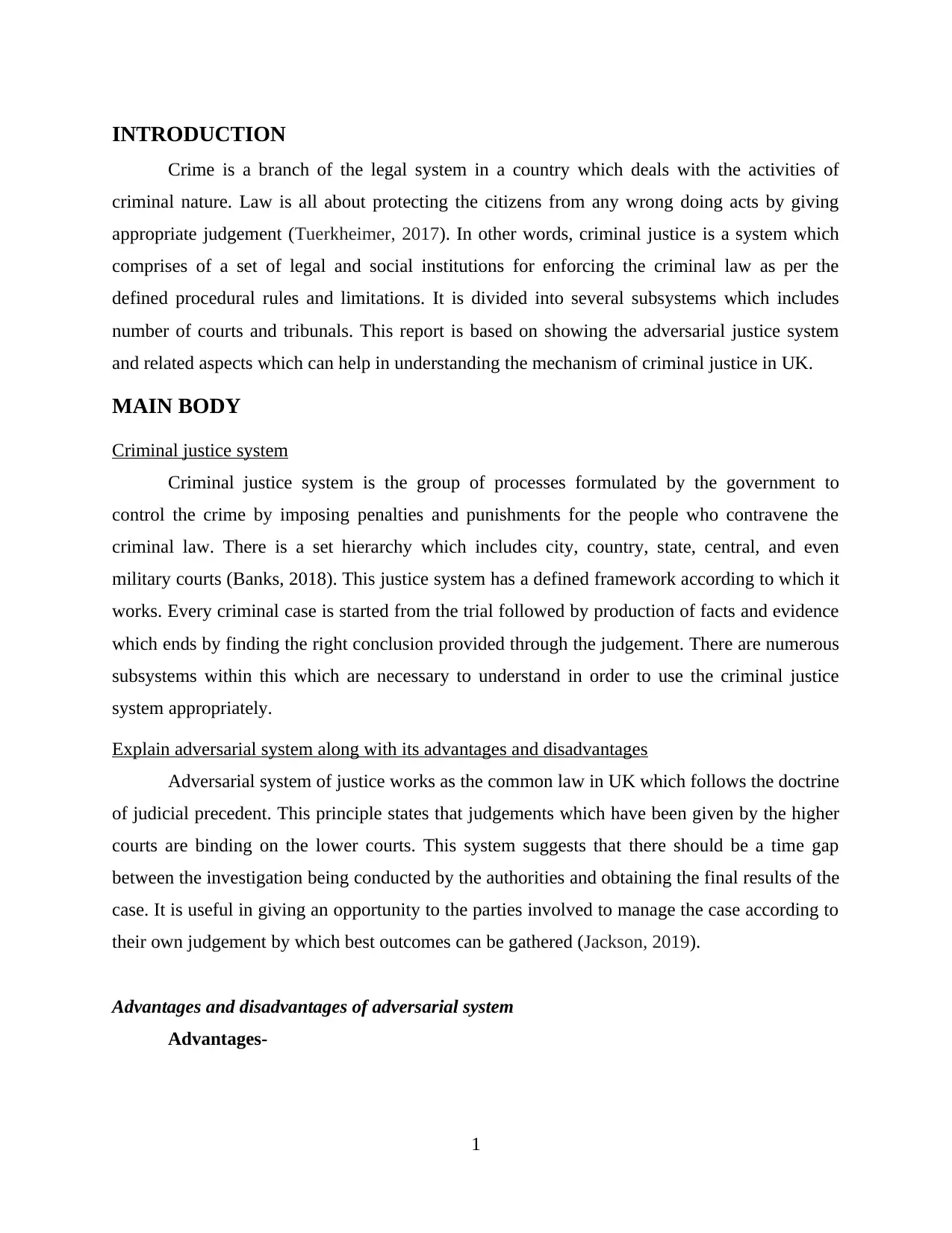
INTRODUCTION
Crime is a branch of the legal system in a country which deals with the activities of
criminal nature. Law is all about protecting the citizens from any wrong doing acts by giving
appropriate judgement (Tuerkheimer, 2017). In other words, criminal justice is a system which
comprises of a set of legal and social institutions for enforcing the criminal law as per the
defined procedural rules and limitations. It is divided into several subsystems which includes
number of courts and tribunals. This report is based on showing the adversarial justice system
and related aspects which can help in understanding the mechanism of criminal justice in UK.
MAIN BODY
Criminal justice system
Criminal justice system is the group of processes formulated by the government to
control the crime by imposing penalties and punishments for the people who contravene the
criminal law. There is a set hierarchy which includes city, country, state, central, and even
military courts (Banks, 2018). This justice system has a defined framework according to which it
works. Every criminal case is started from the trial followed by production of facts and evidence
which ends by finding the right conclusion provided through the judgement. There are numerous
subsystems within this which are necessary to understand in order to use the criminal justice
system appropriately.
Explain adversarial system along with its advantages and disadvantages
Adversarial system of justice works as the common law in UK which follows the doctrine
of judicial precedent. This principle states that judgements which have been given by the higher
courts are binding on the lower courts. This system suggests that there should be a time gap
between the investigation being conducted by the authorities and obtaining the final results of the
case. It is useful in giving an opportunity to the parties involved to manage the case according to
their own judgement by which best outcomes can be gathered (Jackson, 2019).
Advantages and disadvantages of adversarial system
Advantages-
1
Crime is a branch of the legal system in a country which deals with the activities of
criminal nature. Law is all about protecting the citizens from any wrong doing acts by giving
appropriate judgement (Tuerkheimer, 2017). In other words, criminal justice is a system which
comprises of a set of legal and social institutions for enforcing the criminal law as per the
defined procedural rules and limitations. It is divided into several subsystems which includes
number of courts and tribunals. This report is based on showing the adversarial justice system
and related aspects which can help in understanding the mechanism of criminal justice in UK.
MAIN BODY
Criminal justice system
Criminal justice system is the group of processes formulated by the government to
control the crime by imposing penalties and punishments for the people who contravene the
criminal law. There is a set hierarchy which includes city, country, state, central, and even
military courts (Banks, 2018). This justice system has a defined framework according to which it
works. Every criminal case is started from the trial followed by production of facts and evidence
which ends by finding the right conclusion provided through the judgement. There are numerous
subsystems within this which are necessary to understand in order to use the criminal justice
system appropriately.
Explain adversarial system along with its advantages and disadvantages
Adversarial system of justice works as the common law in UK which follows the doctrine
of judicial precedent. This principle states that judgements which have been given by the higher
courts are binding on the lower courts. This system suggests that there should be a time gap
between the investigation being conducted by the authorities and obtaining the final results of the
case. It is useful in giving an opportunity to the parties involved to manage the case according to
their own judgement by which best outcomes can be gathered (Jackson, 2019).
Advantages and disadvantages of adversarial system
Advantages-
1
Paraphrase This Document
Need a fresh take? Get an instant paraphrase of this document with our AI Paraphraser
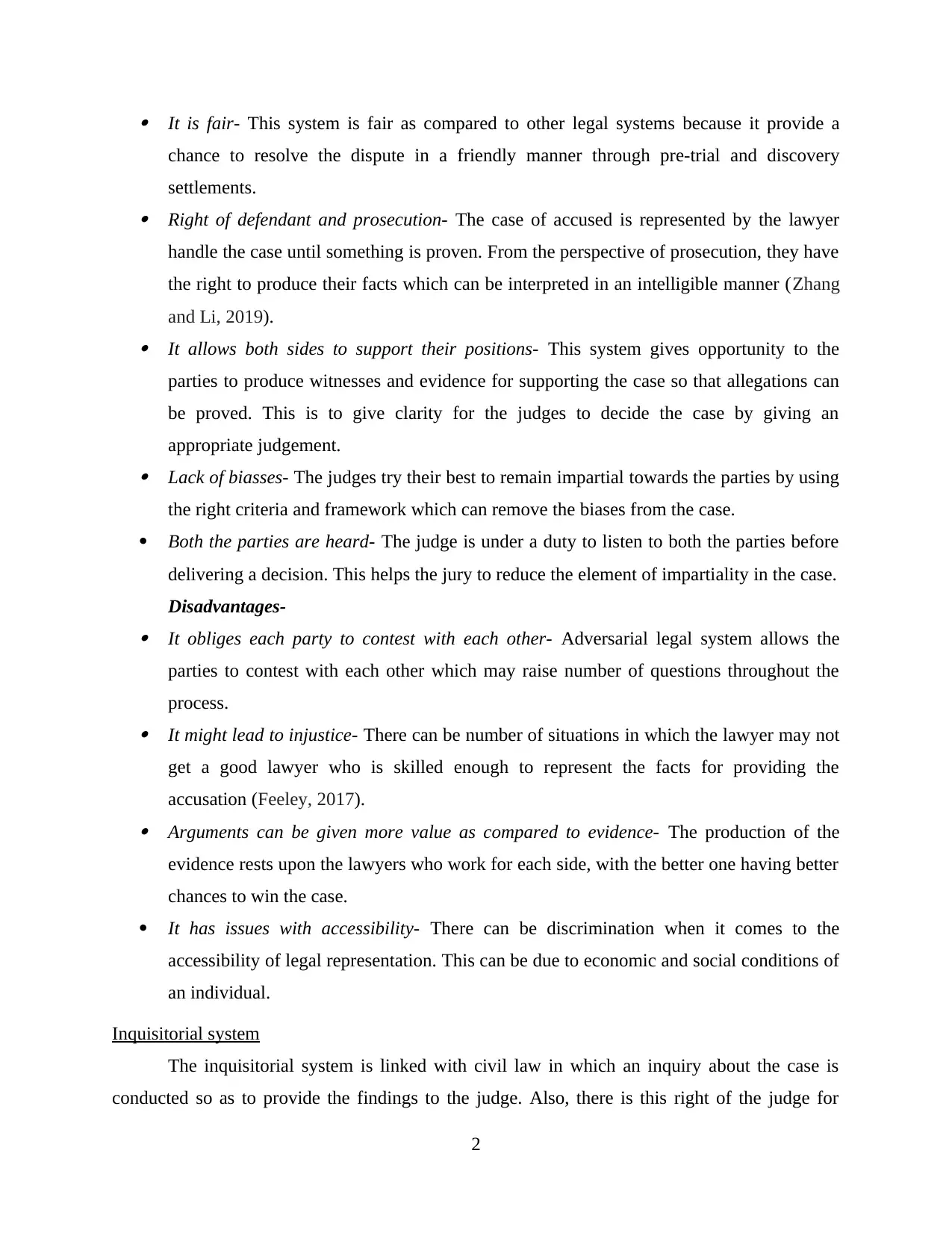
It is fair- This system is fair as compared to other legal systems because it provide a
chance to resolve the dispute in a friendly manner through pre-trial and discovery
settlements. Right of defendant and prosecution- The case of accused is represented by the lawyer
handle the case until something is proven. From the perspective of prosecution, they have
the right to produce their facts which can be interpreted in an intelligible manner (Zhang
and Li, 2019). It allows both sides to support their positions- This system gives opportunity to the
parties to produce witnesses and evidence for supporting the case so that allegations can
be proved. This is to give clarity for the judges to decide the case by giving an
appropriate judgement. Lack of biasses- The judges try their best to remain impartial towards the parties by using
the right criteria and framework which can remove the biases from the case.
Both the parties are heard- The judge is under a duty to listen to both the parties before
delivering a decision. This helps the jury to reduce the element of impartiality in the case.
Disadvantages- It obliges each party to contest with each other- Adversarial legal system allows the
parties to contest with each other which may raise number of questions throughout the
process. It might lead to injustice- There can be number of situations in which the lawyer may not
get a good lawyer who is skilled enough to represent the facts for providing the
accusation (Feeley, 2017). Arguments can be given more value as compared to evidence- The production of the
evidence rests upon the lawyers who work for each side, with the better one having better
chances to win the case.
It has issues with accessibility- There can be discrimination when it comes to the
accessibility of legal representation. This can be due to economic and social conditions of
an individual.
Inquisitorial system
The inquisitorial system is linked with civil law in which an inquiry about the case is
conducted so as to provide the findings to the judge. Also, there is this right of the judge for
2
chance to resolve the dispute in a friendly manner through pre-trial and discovery
settlements. Right of defendant and prosecution- The case of accused is represented by the lawyer
handle the case until something is proven. From the perspective of prosecution, they have
the right to produce their facts which can be interpreted in an intelligible manner (Zhang
and Li, 2019). It allows both sides to support their positions- This system gives opportunity to the
parties to produce witnesses and evidence for supporting the case so that allegations can
be proved. This is to give clarity for the judges to decide the case by giving an
appropriate judgement. Lack of biasses- The judges try their best to remain impartial towards the parties by using
the right criteria and framework which can remove the biases from the case.
Both the parties are heard- The judge is under a duty to listen to both the parties before
delivering a decision. This helps the jury to reduce the element of impartiality in the case.
Disadvantages- It obliges each party to contest with each other- Adversarial legal system allows the
parties to contest with each other which may raise number of questions throughout the
process. It might lead to injustice- There can be number of situations in which the lawyer may not
get a good lawyer who is skilled enough to represent the facts for providing the
accusation (Feeley, 2017). Arguments can be given more value as compared to evidence- The production of the
evidence rests upon the lawyers who work for each side, with the better one having better
chances to win the case.
It has issues with accessibility- There can be discrimination when it comes to the
accessibility of legal representation. This can be due to economic and social conditions of
an individual.
Inquisitorial system
The inquisitorial system is linked with civil law in which an inquiry about the case is
conducted so as to provide the findings to the judge. Also, there is this right of the judge for
2
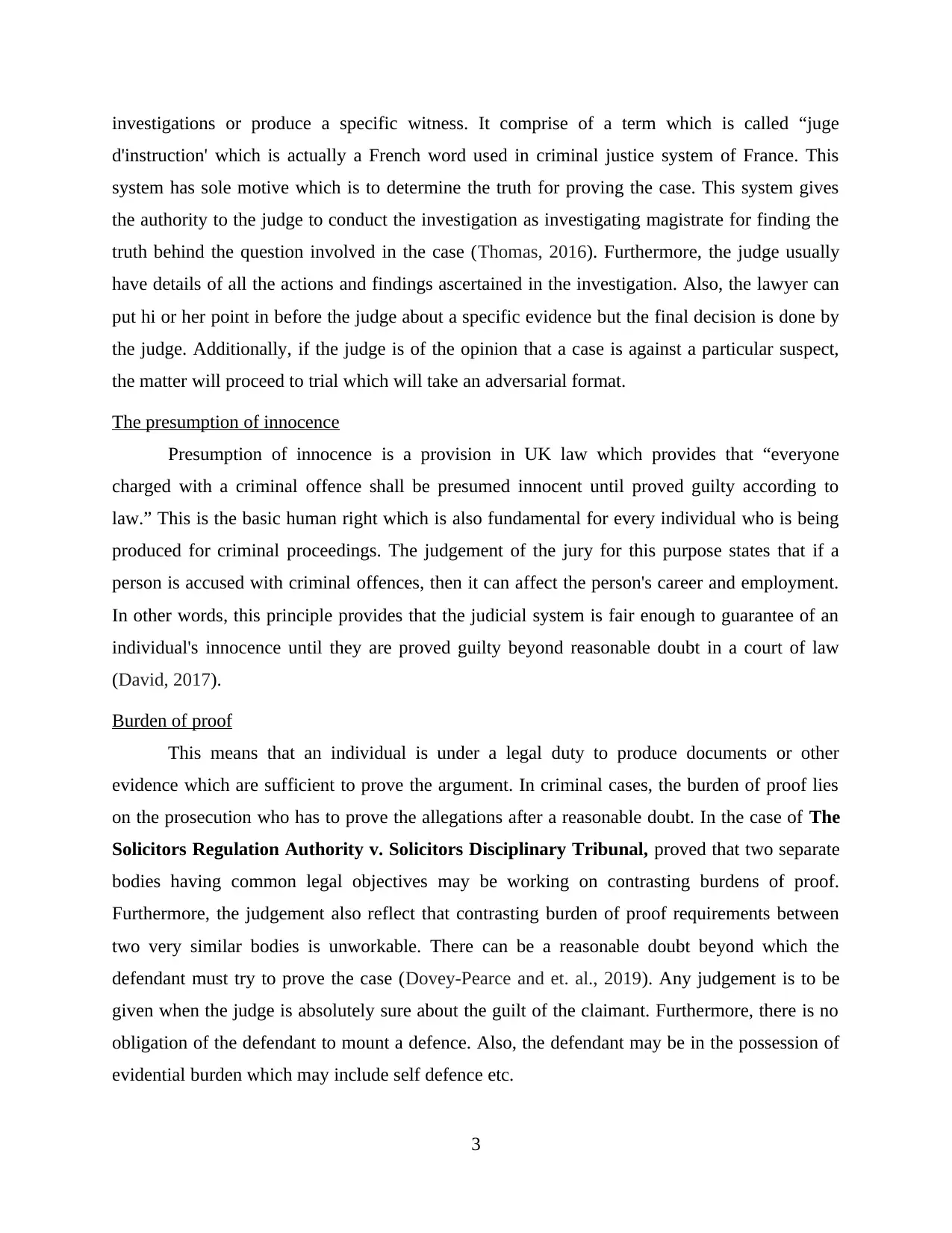
investigations or produce a specific witness. It comprise of a term which is called “juge
d'instruction' which is actually a French word used in criminal justice system of France. This
system has sole motive which is to determine the truth for proving the case. This system gives
the authority to the judge to conduct the investigation as investigating magistrate for finding the
truth behind the question involved in the case (Thomas, 2016). Furthermore, the judge usually
have details of all the actions and findings ascertained in the investigation. Also, the lawyer can
put hi or her point in before the judge about a specific evidence but the final decision is done by
the judge. Additionally, if the judge is of the opinion that a case is against a particular suspect,
the matter will proceed to trial which will take an adversarial format.
The presumption of innocence
Presumption of innocence is a provision in UK law which provides that “everyone
charged with a criminal offence shall be presumed innocent until proved guilty according to
law.” This is the basic human right which is also fundamental for every individual who is being
produced for criminal proceedings. The judgement of the jury for this purpose states that if a
person is accused with criminal offences, then it can affect the person's career and employment.
In other words, this principle provides that the judicial system is fair enough to guarantee of an
individual's innocence until they are proved guilty beyond reasonable doubt in a court of law
(David, 2017).
Burden of proof
This means that an individual is under a legal duty to produce documents or other
evidence which are sufficient to prove the argument. In criminal cases, the burden of proof lies
on the prosecution who has to prove the allegations after a reasonable doubt. In the case of The
Solicitors Regulation Authority v. Solicitors Disciplinary Tribunal, proved that two separate
bodies having common legal objectives may be working on contrasting burdens of proof.
Furthermore, the judgement also reflect that contrasting burden of proof requirements between
two very similar bodies is unworkable. There can be a reasonable doubt beyond which the
defendant must try to prove the case (Dovey‐Pearce and et. al., 2019). Any judgement is to be
given when the judge is absolutely sure about the guilt of the claimant. Furthermore, there is no
obligation of the defendant to mount a defence. Also, the defendant may be in the possession of
evidential burden which may include self defence etc.
3
d'instruction' which is actually a French word used in criminal justice system of France. This
system has sole motive which is to determine the truth for proving the case. This system gives
the authority to the judge to conduct the investigation as investigating magistrate for finding the
truth behind the question involved in the case (Thomas, 2016). Furthermore, the judge usually
have details of all the actions and findings ascertained in the investigation. Also, the lawyer can
put hi or her point in before the judge about a specific evidence but the final decision is done by
the judge. Additionally, if the judge is of the opinion that a case is against a particular suspect,
the matter will proceed to trial which will take an adversarial format.
The presumption of innocence
Presumption of innocence is a provision in UK law which provides that “everyone
charged with a criminal offence shall be presumed innocent until proved guilty according to
law.” This is the basic human right which is also fundamental for every individual who is being
produced for criminal proceedings. The judgement of the jury for this purpose states that if a
person is accused with criminal offences, then it can affect the person's career and employment.
In other words, this principle provides that the judicial system is fair enough to guarantee of an
individual's innocence until they are proved guilty beyond reasonable doubt in a court of law
(David, 2017).
Burden of proof
This means that an individual is under a legal duty to produce documents or other
evidence which are sufficient to prove the argument. In criminal cases, the burden of proof lies
on the prosecution who has to prove the allegations after a reasonable doubt. In the case of The
Solicitors Regulation Authority v. Solicitors Disciplinary Tribunal, proved that two separate
bodies having common legal objectives may be working on contrasting burdens of proof.
Furthermore, the judgement also reflect that contrasting burden of proof requirements between
two very similar bodies is unworkable. There can be a reasonable doubt beyond which the
defendant must try to prove the case (Dovey‐Pearce and et. al., 2019). Any judgement is to be
given when the judge is absolutely sure about the guilt of the claimant. Furthermore, there is no
obligation of the defendant to mount a defence. Also, the defendant may be in the possession of
evidential burden which may include self defence etc.
3
⊘ This is a preview!⊘
Do you want full access?
Subscribe today to unlock all pages.

Trusted by 1+ million students worldwide
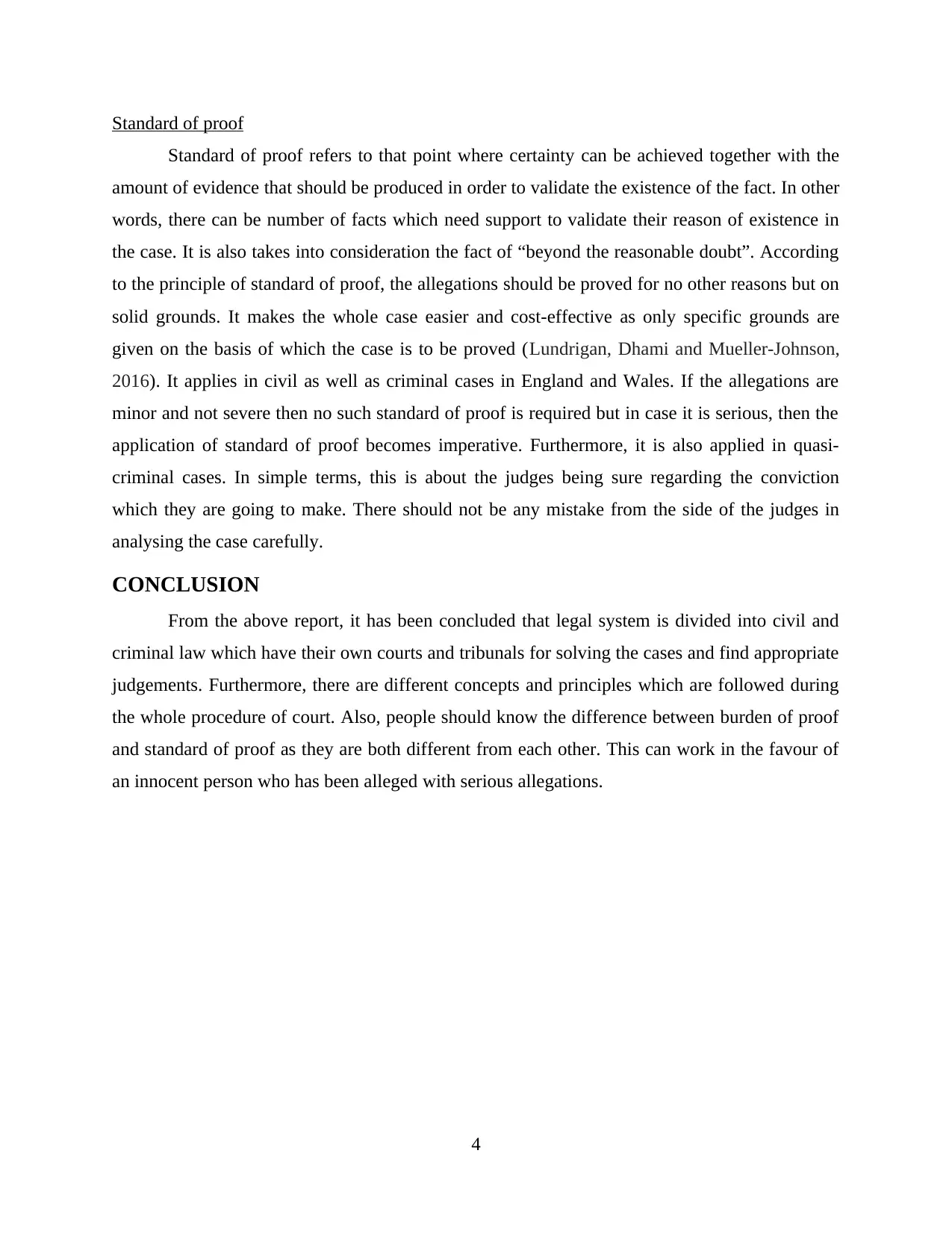
Standard of proof
Standard of proof refers to that point where certainty can be achieved together with the
amount of evidence that should be produced in order to validate the existence of the fact. In other
words, there can be number of facts which need support to validate their reason of existence in
the case. It is also takes into consideration the fact of “beyond the reasonable doubt”. According
to the principle of standard of proof, the allegations should be proved for no other reasons but on
solid grounds. It makes the whole case easier and cost-effective as only specific grounds are
given on the basis of which the case is to be proved (Lundrigan, Dhami and Mueller‐Johnson,
2016). It applies in civil as well as criminal cases in England and Wales. If the allegations are
minor and not severe then no such standard of proof is required but in case it is serious, then the
application of standard of proof becomes imperative. Furthermore, it is also applied in quasi-
criminal cases. In simple terms, this is about the judges being sure regarding the conviction
which they are going to make. There should not be any mistake from the side of the judges in
analysing the case carefully.
CONCLUSION
From the above report, it has been concluded that legal system is divided into civil and
criminal law which have their own courts and tribunals for solving the cases and find appropriate
judgements. Furthermore, there are different concepts and principles which are followed during
the whole procedure of court. Also, people should know the difference between burden of proof
and standard of proof as they are both different from each other. This can work in the favour of
an innocent person who has been alleged with serious allegations.
4
Standard of proof refers to that point where certainty can be achieved together with the
amount of evidence that should be produced in order to validate the existence of the fact. In other
words, there can be number of facts which need support to validate their reason of existence in
the case. It is also takes into consideration the fact of “beyond the reasonable doubt”. According
to the principle of standard of proof, the allegations should be proved for no other reasons but on
solid grounds. It makes the whole case easier and cost-effective as only specific grounds are
given on the basis of which the case is to be proved (Lundrigan, Dhami and Mueller‐Johnson,
2016). It applies in civil as well as criminal cases in England and Wales. If the allegations are
minor and not severe then no such standard of proof is required but in case it is serious, then the
application of standard of proof becomes imperative. Furthermore, it is also applied in quasi-
criminal cases. In simple terms, this is about the judges being sure regarding the conviction
which they are going to make. There should not be any mistake from the side of the judges in
analysing the case carefully.
CONCLUSION
From the above report, it has been concluded that legal system is divided into civil and
criminal law which have their own courts and tribunals for solving the cases and find appropriate
judgements. Furthermore, there are different concepts and principles which are followed during
the whole procedure of court. Also, people should know the difference between burden of proof
and standard of proof as they are both different from each other. This can work in the favour of
an innocent person who has been alleged with serious allegations.
4
Paraphrase This Document
Need a fresh take? Get an instant paraphrase of this document with our AI Paraphraser
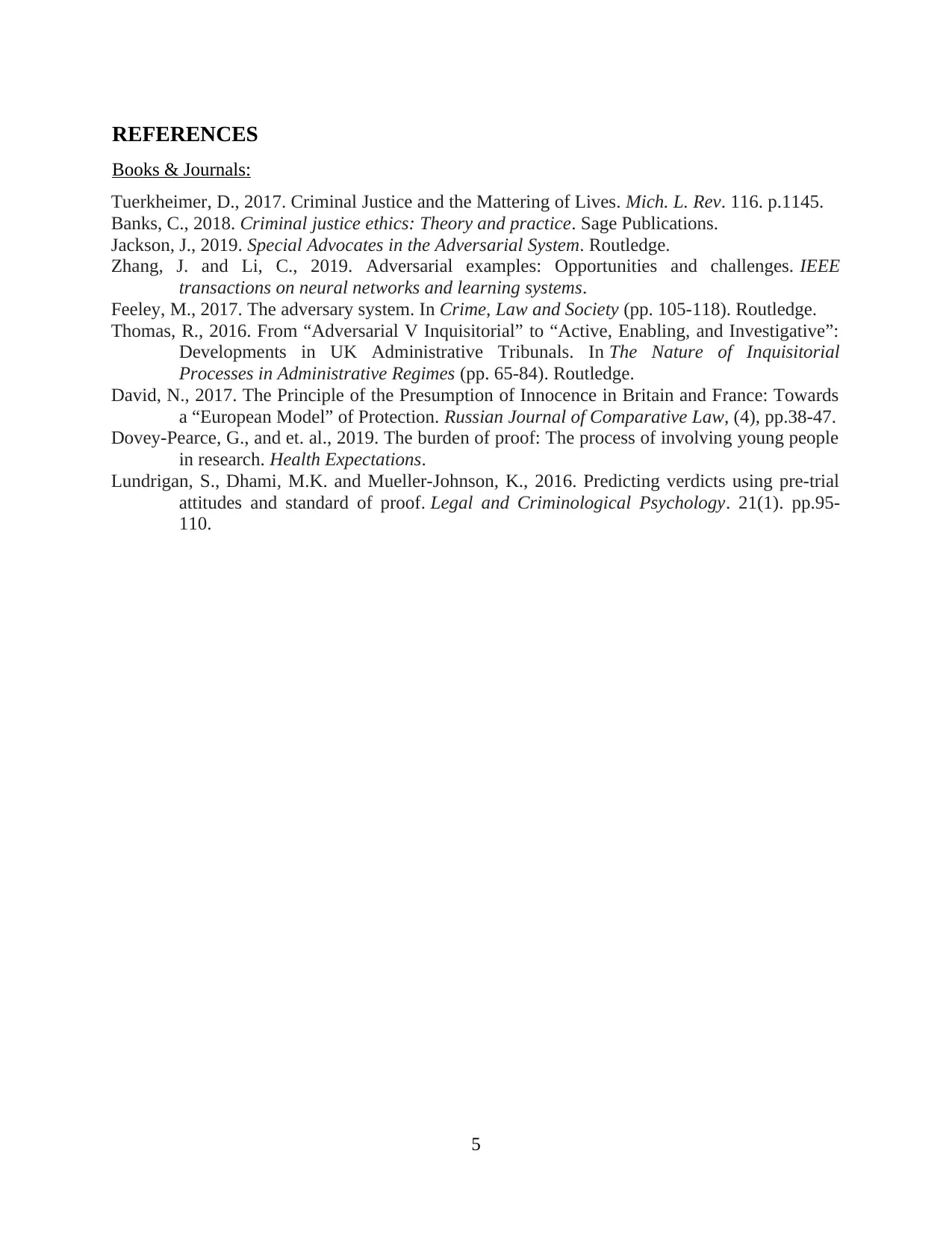
REFERENCES
Books & Journals:
Tuerkheimer, D., 2017. Criminal Justice and the Mattering of Lives. Mich. L. Rev. 116. p.1145.
Banks, C., 2018. Criminal justice ethics: Theory and practice. Sage Publications.
Jackson, J., 2019. Special Advocates in the Adversarial System. Routledge.
Zhang, J. and Li, C., 2019. Adversarial examples: Opportunities and challenges. IEEE
transactions on neural networks and learning systems.
Feeley, M., 2017. The adversary system. In Crime, Law and Society (pp. 105-118). Routledge.
Thomas, R., 2016. From “Adversarial V Inquisitorial” to “Active, Enabling, and Investigative”:
Developments in UK Administrative Tribunals. In The Nature of Inquisitorial
Processes in Administrative Regimes (pp. 65-84). Routledge.
David, N., 2017. The Principle of the Presumption of Innocence in Britain and France: Towards
a “European Model” of Protection. Russian Journal of Comparative Law, (4), pp.38-47.
Dovey‐Pearce, G., and et. al., 2019. The burden of proof: The process of involving young people
in research. Health Expectations.
Lundrigan, S., Dhami, M.K. and Mueller‐Johnson, K., 2016. Predicting verdicts using pre‐trial
attitudes and standard of proof. Legal and Criminological Psychology. 21(1). pp.95-
110.
5
Books & Journals:
Tuerkheimer, D., 2017. Criminal Justice and the Mattering of Lives. Mich. L. Rev. 116. p.1145.
Banks, C., 2018. Criminal justice ethics: Theory and practice. Sage Publications.
Jackson, J., 2019. Special Advocates in the Adversarial System. Routledge.
Zhang, J. and Li, C., 2019. Adversarial examples: Opportunities and challenges. IEEE
transactions on neural networks and learning systems.
Feeley, M., 2017. The adversary system. In Crime, Law and Society (pp. 105-118). Routledge.
Thomas, R., 2016. From “Adversarial V Inquisitorial” to “Active, Enabling, and Investigative”:
Developments in UK Administrative Tribunals. In The Nature of Inquisitorial
Processes in Administrative Regimes (pp. 65-84). Routledge.
David, N., 2017. The Principle of the Presumption of Innocence in Britain and France: Towards
a “European Model” of Protection. Russian Journal of Comparative Law, (4), pp.38-47.
Dovey‐Pearce, G., and et. al., 2019. The burden of proof: The process of involving young people
in research. Health Expectations.
Lundrigan, S., Dhami, M.K. and Mueller‐Johnson, K., 2016. Predicting verdicts using pre‐trial
attitudes and standard of proof. Legal and Criminological Psychology. 21(1). pp.95-
110.
5

6
⊘ This is a preview!⊘
Do you want full access?
Subscribe today to unlock all pages.

Trusted by 1+ million students worldwide
1 out of 9
Related Documents
Your All-in-One AI-Powered Toolkit for Academic Success.
+13062052269
info@desklib.com
Available 24*7 on WhatsApp / Email
![[object Object]](/_next/static/media/star-bottom.7253800d.svg)
Unlock your academic potential
Copyright © 2020–2025 A2Z Services. All Rights Reserved. Developed and managed by ZUCOL.




